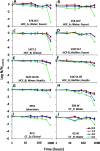Local Adaptation of Legionella pneumophila within a Hospital Hot Water System Increases Tolerance to Copper
- PMID: 33674435
- PMCID: PMC8117758
- DOI: 10.1128/AEM.00242-21
Local Adaptation of Legionella pneumophila within a Hospital Hot Water System Increases Tolerance to Copper
Abstract
In large-building water systems, Legionella pneumophila is exposed to common environmental stressors such as copper. The aim of this study was to evaluate the susceptibility to copper of L. pneumophila isolates recovered from various sites: two clinical and seven environmental isolates from hot water system biofilm and water and from cooling tower water. After a 1-week acclimation in simulated drinking water, strains were exposed to various copper concentrations (0.8 to 5 mg/liter) for over 672 h. Complete loss of culturability was observed for three isolates following copper exposure to 5 mg/liter for 672 h. Two sequence type 1427 (ST1427)-like isolates were highly sensitive to copper, while the other two, isolated from biofilm samples, maintained higher culturability. The expression of the copper resistance gene copA evaluated by reverse transcription-quantitative PCR (RT-qPCR) was significantly higher for the biofilm isolates. All four ST1427-like isolates were recovered from the same water system during an outbreak. Whole-genome sequencing results confirmed that the four isolates are very close phylogenetically, differing by only 29 single nucleotide polymorphisms, suggesting in situ adaptation to microenvironmental conditions, possibly due to epigenetic regulation. These results indicate that the immediate environment within a building water distribution system influences the tolerance of L. pneumophila to copper. Increased contact of L. pneumophila biofilm strains with copper piping or copper alloys in the heat exchanger might lead to local adaptation. The phenotypic differences observed between water and biofilm isolates from the hot water system of a health care facility warrants further investigation to assess the relevance of evaluating disinfection performances based on water sampling alone.IMPORTANCELegionella pneumophila is a pathogen indigenous to natural and large building water systems in the bulk and the biofilm phases. The immediate environment within a system can impact the tolerance of L. pneumophila to environmental stressors, including copper. In health care facilities, copper levels in water can vary, depending on water quality, plumbing materials, and age. This study evaluated the impact of the isolation site (water versus biofilm, hot water system versus cooling tower) within building water systems. Closely related strains isolated from a health care facility hot water system exhibited variable tolerance to copper stress, shown by differential expression of copA, with biofilm isolates displaying highest expression and tolerance. Relying on the detection of L. pneumophila in water samples following exposure to environmental stressors such as copper may underestimate the prevalence of L. pneumophila, leading to inappropriate risk management strategies and increasing the risk of exposure for vulnerable patients.
Keywords: Legionella pneumophila serogroup 5; biofilm; cooling tower; copA; hot water system; premise plumbing; whole-genome sequencing.
Copyright © 2021 American Society for Microbiology.
Figures




References
-
- Benedict K, Reses H, Vigar M, Roth DM, Roberts VA, Mattioli M, Cooley LA, Hilborn ED, Wade TJ, Fullerton K, Yoder J, Hill VR. 2017. Surveillance for waterborne disease outbreaks associated with drinking water—United States, 2013–2014. MMWR Morb Mortal Wkly Rep 66:1216–1220. 10.15585/mmwr.mm6644a3. - DOI - PMC - PubMed
-
- European Centre for Disease Prevention and Control. 2017. Legionnaires' disease. In ECDC annual epidemiological report for 2015. European Centre for Disease Prevention and Control, Stockholm, Sweden. https://www.ecdc.europa.eu/sites/default/files/documents/AER_for_2015-le....
-
- Centers for Disease Control and Prevention. 2017. Active bacterial core surveillance (ABCs) report emerging infections program network: legionellosis, 2015. CDC, Atlanta, GA.
Publication types
MeSH terms
Substances
LinkOut - more resources
Full Text Sources
Other Literature Sources
Medical
Molecular Biology Databases

